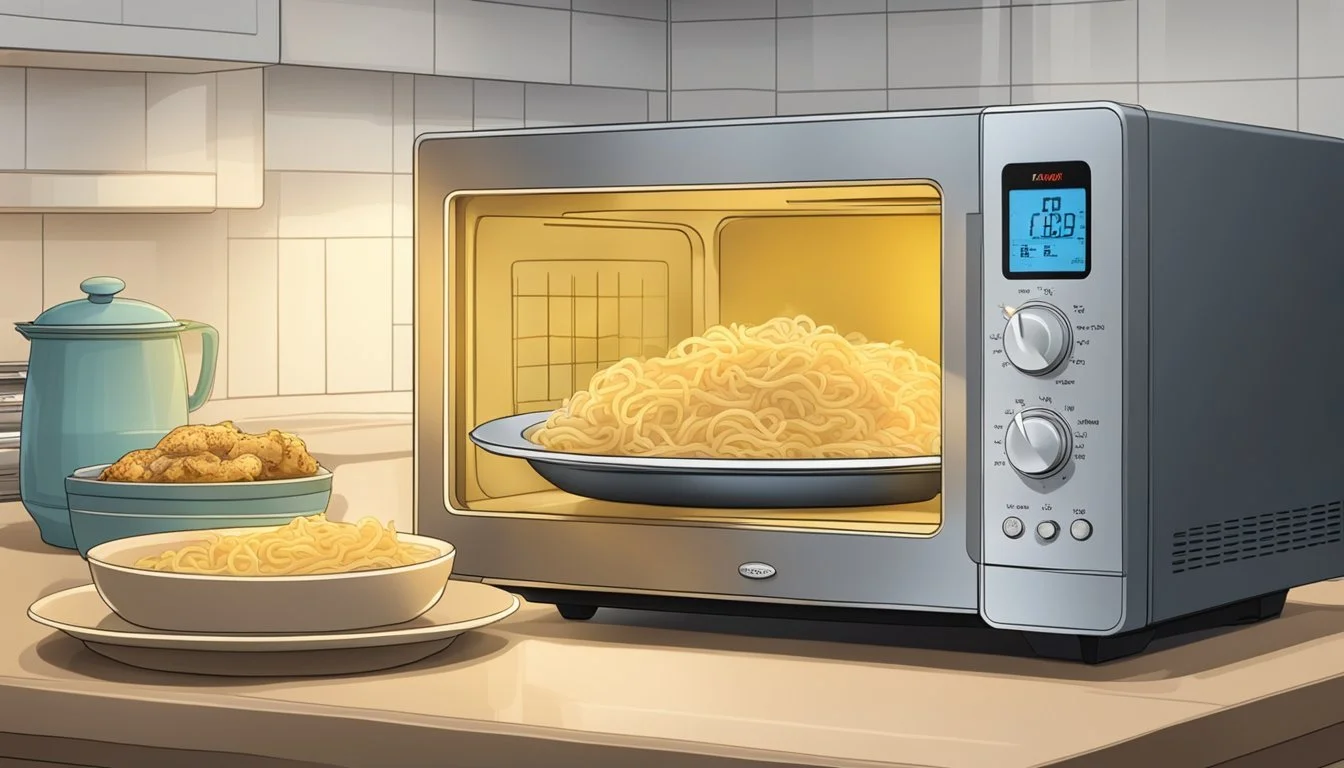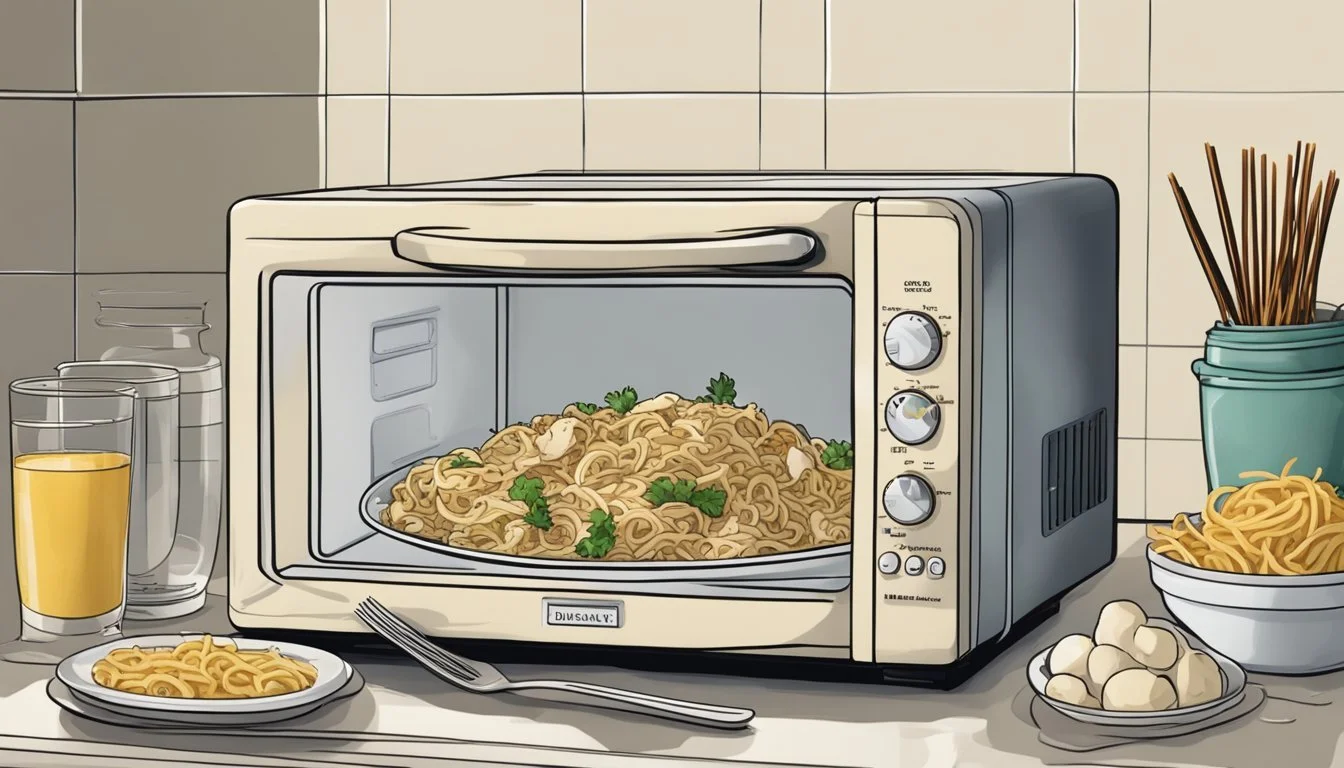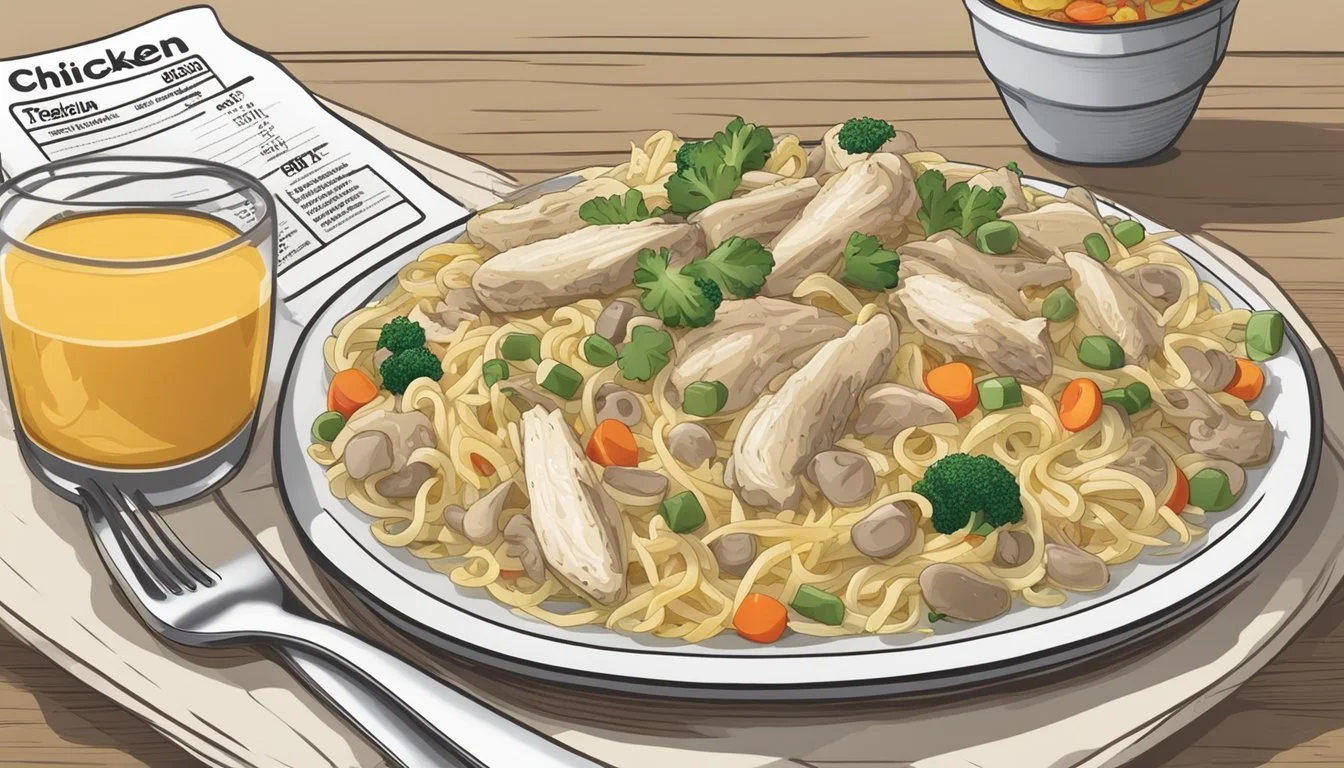How to Reheat Chicken Tetrazzini for Perfect Leftovers
Reheating chicken tetrazzini can often seem like a daunting task, especially when you're hoping to preserve that creamy richness and savory flavor that makes this dish so delightful. The best way to reheat chicken tetrazzini is in the oven at 350°F (175°C), covered with foil, for about 30 minutes until heated through. This method ensures that the meal remains moist and flavorful, avoiding the common pitfall of drying out the dish.
Using the oven isn't the only method available, though it's widely trusted for maintaining the dish's integrity. For those in a hurry, the microwave offers a quick alternative. To prevent the pasta from drying out, adding a splash of water or broth before covering and microwaving works wonders. The stovetop can also achieve a great result, especially when a bit of additional sauce or cheese is mixed in to reinvigorate the leftovers.
Understanding the right reheating strategies is key to savoring chicken tetrazzini again just as much as when it was freshly made. It's all about choosing the method that fits your schedule while still preserving the meal's original flavors and texture. Whether you're reheating a single portion or preparing to serve a family dinner, these tips will help ensure that your leftovers are delicious and satisfying.
Understanding Chicken Tetrazzini
Chicken Tetrazzini is a classic American comfort food. This delicious pasta dish often features a creamy sauce made from ingredients like butter, cream, and Parmesan cheese.
Typically, it includes chunks of cooked chicken, sautéed mushrooms, and al dente pasta.
The recipe starts with a flavorful base of onions and mushrooms, which are cooked until tender. Flour is added to create a roux, followed by the addition of broth, white wine, and heavy cream. This forms the rich, creamy sauce that coats the pasta and chicken.
Chicken Tetrazzini is usually baked in the oven. The pasta and sauce mixture is often transferred to a baking dish, topped with cheese, and baked until bubbly and golden brown.
This method ensures a harmonious melding of flavors and a delicious, crisp topping.
The dish can be high in calories due to its rich ingredients. For those monitoring their intake, portion control and using lighter versions of cream and cheese can help manage the calorie content.
Despite its richness, Chicken Tetrazzini offers a good amount of protein from the chicken and dairy ingredients. The inclusion of vegetables like mushrooms adds flavor and nutrition.
Here's a breakdown of some key ingredients:
Chicken: Provides protein and a savory element.
Mushrooms: Add depth of flavor and texture.
Parmesan Cheese: Enhances the cheesy, umami notes.
Pasta: Serves as the hearty base.
Cream: Creates the signature creamy sauce.
This dish is a beloved choice for gatherings and family meals, cherished for its comforting, satisfying nature.
Preparation Before Reheating
Proper preparation ensures your chicken tetrazzini retains its flavor and texture. It's important to check the condition of the dish and follow safety tips for handling leftovers.
Checking Chicken Tetrazzini Condition
Before reheating, inspect the dish to ensure it's safe to eat.
Check for any unusual odors or signs of spoilage. Spoiled chicken tetrazzini may have a sour smell or visible mold. If stored in the fridge, leftovers should be consumed within 3-4 days. If frozen, ensure it was sealed well with plastic wrap or airtight containers to prevent freezer burn. Freezer burn can cause dry spots and affect taste.
Visually inspect for changes in color or texture. If there is any doubt about its quality, it's safer to discard it.
Safety Tips for Handling Leftovers
Proper handling of leftovers is key to preventing foodborne illness.
Always keep leftovers in the fridge at or below 40°F (4°C). If stored in the freezer, keep at 0°F (-18°C) or below. Use airtight containers or plastic wrap to store the chicken tetrazzini.
When ready to reheat, ensure it's thoroughly thawed if it was frozen. Defrost in the fridge overnight, not at room temperature, to maintain food safety. If you're in a hurry, use a microwave’s defrost setting.
Make sure all parts of the dish reach an internal temperature of 165°F (74°C) to kill any potential bacteria.
By following these steps, you can enjoy your chicken tetrazzini safely and deliciously.
Reheating Methods
Chicken Tetrazzini, known for its creamy pasta and baked casserole style, can be reheated using several methods to maintain its flavor and texture. Each method has specific steps to ensure the dish remains tasty and moist.
Oven Reheating Instructions
Preheat: Begin by preheating the oven to 350°F (175°C).
Preparation: Place the Chicken Tetrazzini in an oven-safe dish. If it was refrigerated, let it sit at room temperature for about 20 minutes.
Reheating: Cover the dish with foil to avoid drying out the creamy pasta. Bake for 20-25 minutes. If the dish was frozen, it might take up to 40-45 minutes.
Check: Remove the foil for the last 5-10 minutes to allow the top to become slightly crispy. Check if the internal temperature reaches 165°F using a meat thermometer.
Microwave Reheating Tips
Preparation: Place a serving of Chicken Tetrazzini on a microwave-safe plate. Spread it out evenly for uniform heating.
Add Moisture: Sprinkle a few drops of water over the pasta to keep it from drying out. Cover the plate with a microwave-safe lid or another plate.
Heat: Microwave on medium power for 2-3 minutes. Stir halfway through to ensure even heating.
Check: After the initial heating, check if the dish is hot and creamy. If not, continue to microwave in 30-second intervals until it reaches an internal temperature of 165°F. Avoid overcooking as it can dry out the dish.
Using an Air Fryer to Reheat
Preparation: Set the air fryer to 350°F. Place the Chicken Tetrazzini in an air fryer-safe baking dish. Ensure the dish is not too crowded to allow air circulation.
Reheating: Reheat for 7-10 minutes. Stir halfway through to ensure even heating. If it starts to dry out, you can lightly spray with cooking oil.
Check: Ensure the internal temperature reaches 165°F. The air fryer will help achieve a slightly crispy texture on top while keeping the inside creamy.
With these methods, you can enjoy your Chicken Tetrazzini with the same deliciousness as when it was first baked.
Optimizing Taste and Texture
To ensure reheated chicken tetrazzini retains its delightful flavor and texture, it's essential to focus on maintaining creaminess, crisping the top layer, and preventing dryness.
Maintaining Creaminess
Retaining the creamy texture of the cheese sauce is key. Add a bit of milk or cream to the dish before reheating to help revive its original consistency.
When reheating in the oven, cover the dish with aluminum foil to trap moisture. This helps prevent the sauce from drying out.
Stirring in some extra mushroom soup or a small amount of melted butter can also help enhance the creaminess. Be sure to reheat at a moderate temperature, typically around 350°F (175°C).
Crisping the Top Layer
Achieving a crispy top layer adds a satisfying texture contrast. Sprinkle fresh breadcrumbs mixed with melted butter and a touch of olive oil over the tetrazzini before reheating.
For an extra cheesy crust, blend in some shredded mozzarella or cheddar.
Bake uncovered for a few minutes at the end to allow the breadcrumbs and cheese to brown and crisp up. You may also consider broiling briefly, keeping a close eye to avoid burning.
Preventing Dryness
Preventing dryness is crucial to keeping chicken tetrazzini enjoyable. Start by adding a small amount of chicken broth to the pasta, which helps keep the moisture levels up.
Cover the dish with foil during most of the reheating process to prevent moisture loss. Don't overcook; reheating should just be long enough to warm the dish through, not to cook it further.
Incorporating a bit of creamy mushroom sauce or extra cheese can also keep the dish from becoming too dry.
Careful attention to these steps will ensure a delicious, enjoyable chicken tetrazzini, preserving the richness and texture that makes it a favorite.
Additional Tips and Tricks
Enhance your reheated chicken tetrazzini by incorporating fresh herbs and extra cheese. Proper storage is essential for maintaining the dish's quality post-reheating.
Incorporating Fresh Herbs
Fresh herbs like parsley or thyme can bring a burst of flavor to reheated chicken tetrazzini. Sprinkle finely chopped parsley over the dish after reheating to add a fresh, vibrant taste.
Adding herbs such as basil or oregano enhances the overall flavor profile. For more depth, consider sautéing minced garlic and onion along with the reheated dish.
Herbs should be added towards the end of the reheating process to preserve their aromas and delicate flavors. This approach ensures that the dish retains its creamy and savory essence with a hint of freshness.
Enhancing with Extra Cheese
Adding extra cheese can make your reheated chicken tetrazzini even more indulgent. Grated Parmesan cheese melts beautifully and enriches the dish with its nutty flavor.
Consider mixing a handful of grated Parmesan into the pasta before reheating. Mozzarella or cheddar can also be added for a gooey texture. For a crispy topping, sprinkle cheese and then broil for a few minutes until it turns golden brown.
Using a mixture of cheeses can amplify the creaminess, enhancing the decadence of the dish. Be careful not to overpower the original flavors, maintaining a balance is key.
Storage Advice Post-Reheating
Proper storage is crucial to keep your chicken tetrazzini fresh after reheating. Transfer leftovers to an airtight container once cooled.
Refrigerate within two hours to prevent bacteria growth. To retain moisture, add a splash of milk or water when reheating again. Store in portion-sized containers to make future reheating easier and more efficient.
Avoid repeated reheating, as this can degrade the texture and flavor. Leftover veggies or noodles should be stored separately if possible. Label the containers with the date to keep track of freshness, ensuring the dish is consumed within 3-4 days.
Avoiding Common Mistakes
Dry Chicken Tetrazzini
A common issue when reheating chicken tetrazzini is drying out the dish. To preserve moisture, cover it with foil before placing it in the oven. This helps retain steam and keeps the texture of the dish creamy without letting it become dry or tough.
High Heat Problems
Using high heat can lead to uneven heating and can scorch the top layer while leaving the center cold. Always reheat at a moderate temperature, like 350°F (175°C), to ensure uniform warmth.
Overcooking Pasta
Pasta can quickly become mushy if overheated. To avoid this, reheat just until the dish is cooked through. Check periodically to prevent overcooking and maintain the desired texture.
Preserving Flavor
Frequent reheating can diminish the flavor of the tetrazzini. It's best to reheat only the portion you plan to eat. This practice helps to maintain the rich, savory flavors of the dish in each serving.
Cream and Cheese Separation
When reheating, cream and cheese tend to separate and become grainy. Stirring the dish halfway through reheating can help reincorporate these ingredients, ensuring a smooth and creamy outcome.
Avoiding Excess Salt
Reheating can sometimes concentrate flavors, making the dish saltier. If the dish tastes too salty, consider adding a splash of cream or a bit of water to balance it out.
Oven Baking
For best results, reheat chicken tetrazzini in the oven. It provides even heat and helps to maintain the dish's structure and moisture. Avoid using a microwave, which often results in uneven heating and a loss of texture.
Pairing Ideas for Chicken Tetrazzini
Garlic Bread is a perfect complement to Chicken Tetrazzini. Its crispy texture and garlic flavor enhance the creamy richness of the pasta. Serve it warm and buttery for an inviting addition.
A fresh salad makes a great side dish. A simple mixed greens salad with a light vinaigrette balances the heaviness of the tetrazzini. Adding elements like cherry tomatoes or cucumbers provides a refreshing contrast.
Pairing Chicken Tetrazzini with white wine elevates the dining experience. Opt for a Chardonnay or Sauvignon Blanc. Both wines have a balance of acidity and flavor that harmonize with the creamy sauce.
Introducing a variety of vegetables alongside Chicken Tetrazzini not only adds nutrition but also provides a different texture. Steamed broccoli or sautéed green beans are excellent choices. Their subtle flavors complement the dish without overpowering it.
Consider the following pairing options for a complete and satisfying meal:
Sides Description Garlic Bread Warm, crispy with a hint of garlic flavor Mixed Salad Light, refreshing with a vinaigrette Steamed Broccoli Simple, nutritious, and easy to prepare White Wine Chardonnay or Sauvignon Blanc
Nutritional Information
The nutritional content of Chicken Tetrazzini can vary based on the specific recipe and ingredients used. Understanding the basic nutritional breakdown helps in maintaining a balanced diet.
Calories: A standard serving of Chicken Tetrazzini (around 1 cup) typically contains about 300-400 calories. This can vary depending on the amount of cheese, cream, and pasta.
Protein: Chicken Tetrazzini provides a good source of protein. A typical serving usually contains approximately 20-25 grams of protein, mainly from the chicken.
Carbohydrates: Carbohydrate content is largely dependent on the pasta. One serving typically has 30-40 grams of carbohydrates. Using whole wheat pasta can increase the fiber content.
Fat Content: The fat content can range from 15-25 grams per serving. The use of ingredients like butter, cream, and cheese contribute to this. Opting for lower-fat versions of these ingredients can reduce the fat content.
Serving Size: The nutritional values mentioned are based on a serving size of about 1 cup. Adjusting the serving size will accordingly change the nutritional intake.
Nutritional elements, like sodium and sugar, can also be present. Monitoring ingredient choices can aid in managing these values.
For those looking to control their dietary intake, consulting nutritional labels and adjusting ingredient quantities can provide a more tailored measurement.







